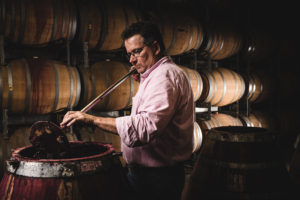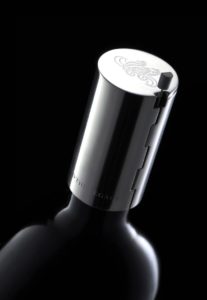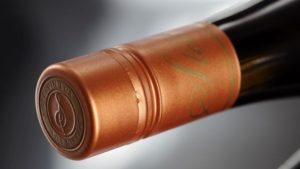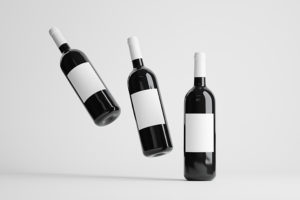In presenting my very first seminar, one designed to showcase which wines excel in different regions of the world, I saved a bottle of Zenato Amarone for last—ready to impress the gathering with one of Italy’s more famed creations.
Anticipation was high, since the assembled folk had been duly impressed with my previous choices. Then I uncorked it, sniffed the cork, smelled the wine, and thought, “Oh frig.”
There it was—that distinct musty, wet cardboard scent of cork taint.
Perhaps I was being overly sensitive. But as a sampled a first and then second sip of what should have been the highlight of the night, there was no hiding it. It was as though the acid and fruit had been sucked clean from the contents. (It was also the first and last time I have ever uncorked an important wine for a presentation without sampling it first.)
As with any of our senses, some people’s ability to detect various smells and tastes is more acute than others’. I do seem to be pretty sensitive to the telltale chemical cork-tainting element of TCA (2,4,6 – trichloroanisole), which is probably one of the reasons why I’ve sent more bottles back at the restaurant and returned more to the LCBO than most folks.
In every case but one, those bottles were sealed with corks—the exception being a bottle that had somehow developed mold beneath the foil wrap. When I unscrewed the cap, hoping it was just the foil that had been affected, I could detect a damp newspaper smell right away.
SCREW IT!
But while even screw-capped wines can contain TCA if the spores were present in the winery, it’s really rare. It’s why the Stelvin closure—with an aluminum cap that screws onto threads on the neck of a wine bottle with a metal skirt down the neck to resemble the traditional foil wrap—was invented in the first place. The process was initiated in 1964 by Peter Wall, then production director of Australia’s Yalumba winery. Tired of his wines being ravaged by cork taint, Wall approached a French company, Le Bouchage Mécanique, to explore an alternative.
While the Stelvin closure the company created quickly gained momentum in the early 1970s, replacing the age-old cork for a screw cap has been hard concept for some wine lovers to accept.
But it was an easy decision for some.
“I measured cork taint at 17%, but I may have been overzealous,” Adam Eggins, Chief Winemaker at Australia’s noted Taylors/Wakefield Wines, shared with me about his winery’s depressing 1999 experience. “So we did not release that vintage of St Andrews Riesling and Chardonnay, which was heartbreaking, as they were our best work of that year. It was, in many ways, the straw that broke the camel’s back and helped us decide to move to a screw cap.”

Eggins made the gut-wrenching decision to scrap an entire vintage of his prized Riesling and Chardonnay in 1999 due to cork taint.
Here’s a little history lesson from Eggins. “This is the short version. In 2000, the Clare Valley winemakers took a brave step in launching the second coming of the screw cap. The first occurred in the 1960s and 1970s, but didn’t really connect with consumers. (The winery’s CEO), Mitchell Taylor, was very brave and took a lead position in 2000—this by having the largest single exposure to the 14 wineries who joined in. Only three went to 100% screw caps on the 2000 Riesling.
“Two years later, in 2002, those pesky New Zealand friends joined in with screw caps on their Sauvignon Blanc. Like an unstoppable All Black, NZ Sauvignon Blanc went global and so did the screw cap. So in 2004, we hit back, bottling red wines—and all our wines—under screw cap.
“We haven’t looked back and won’t be returning to cork for many reasons,” Eggins says. “Originally, we zoomed in on technical faults, because many of us from this side of the world were having major problems with TCA. Three or four technical faults were identified as the main reason to look for a better closure:
- TCA & his mates (There is more than one compound.)
- Gas & moisture exchange (Corks can dry out and oxidize wine.)
- Flavour & colour scalping (corks are absorbent and can literally suck the perfume—that subtlety that is sometimes the difference between good and great—permanently out of a wine and into the cork. That’s when you throw it in the bin, including the good stuff.)
LOVING THE CAP
“Anyhow, after a few years of fighting these three foes, a new understanding about the screw cap developed,” Eggins says. “The New World wine industry fell in love with the screw cap for new reasons not at all technical:
- Screw caps are more predictable and more known.
- Screw caps decrease customer returns in the liquor industry. (This can be a major cost to the industry, and has been estimated at about 5% in the UK.)
- Convenience (Have a glass, seal it, put it back in the fridge for tomorrow—this observation from some of the largest retailers on earth.)
- Comments from key sommeliers (‘Forget the romance of pulling a cork. We love screw caps. If you want romance, offer to decant the wine at the table. With screw caps, our waiting staff can focus more energy on customers’ needs and not have to worry about removing a cork and what happens if the cork fails.’)
“The final nail in the coffin for cork, from where I sit,” Eggins continues, “was something (Australian wine writer and critic) James Halliday said: ‘For the first time, I can taste the oak in wine as the winemaker intended; not the wood of the cork.’ James was 100% correct. Cork can impart a character known as ‘cork wood,’ which is often described as forest floor, mouldy truffles, earthiness and sometimes bitterness.
“One of the big cork companies admitted…they can remove the flavour of wood from the cork, which means for a long time cork may have been tainting wine with a natural but unintended oak contribution.”
“We’re very proud of being the first major winery in Australia to go 100% screw cap and we’re also very proud of how well the matured wines under screw cap are looking now that they are reaching their full term,” noted Master of Wine Neil Hadley, Export General Manager for Taylors Wakefield, a few months back. “I’ve had the pleasure in the last 10 days of opening our 2010 Visionary for four separate events. Every bottle was perfect and the wine itself evolving beautifully into middle age. In our cellar, we have 2003 reds under both screwcap and cork (the St Andrews Shiraz—we split the vintage just to see). There hasn’t been a single instance of us ever saying, “Gee, maybe we should have stuck with the cork.”

The Legacy, Wakefield’s ultra-premium 50th anniversary red wine, features a high-tech cover that, when removed, sends a signal off a satellite to the winery to alert them that the bottle has been opened. Beneath the cover, though, this $1,000 bottle is sealed with a screw cap, not a cork.
Need further evidence of how much the winery believes in the technology? I was lucky enough to attend the Toronto launch earlier this year of Wakefield’s pinnacle of winemaking, The Legacy, a $1,000 apiece Cabernet Sauvignon-based Bordeaux blend. How did they seal the mere 1,080 bottle production? With a screw cap.
OF MARKETING AND ROMANCE
But not everybody is ready to 100% commit. While giant Aussie winemaker Penfolds seals its entire range of white wines with screw caps, marketing trumps science when it comes to their most prolific reds. Within Australia, the vast majority of the winery’s red wines, including triple-digit pricings such as their 2016 RWT Bin 798 Shiraz, are admittedly topped with a screw cap. North American shipments of many of those high-end creations, on the other hand, are fitted with corks. Why? Because many here still have the perception that there has to be a cork in the bottle to take it that seriously.
“What’s important to remember it is that it’s also about packaging, presentation and the experience of the consumer,” Luc Desroches, Sales Managing Director of Canada with Masi Agricola, told me in September. “For a certain number of years, we had a serious issue. The level of defective corks that were flowing around in the industry was so high that it was totally unacceptable—we heard 8%, although our experience when we were doing tastings was almost 12%. It was crazy. I’m French Canadian, and I used to say, ‘You know, we’re very proud of (airplane manufacturer) Bombardier. Can you imagine if one out of 10 planes fell down, and we just said that’s part of the problem we’re facing?’

The Stelvin LUX closure features a more elegant look, with no external threading.
“No, we want to take a more serious approach. And I think cork producers reacted very seriously to that crisis,” Desroches says. “And we have at the same time removed pressure on the cork industry by having more wines that are made to be consumed in a shorter period of time. Those were perfect to switch to the Stelvin closure or twist cap. We decided to use the Stelvin LUX—its look is more elegant and with a high-performing twist cap. Why? Because elegance is important. When you bring a bottle of wine and you have it with friends and guests, you want something pleasant to open and taste.
“But for our more serious wines, we strongly believe in a premium quality, all-natural cork, because we still believe that the wine in a bottle will breathe through the cork,” Desroches says. “Others believe that wine will age in an anaerobic situation, meaning that it doesn’t need air transported between the wine and the outside.
“A great example, is a wine we (poured at the Grandi Marchi tasting at the Royal Ontario Museum in September), Pian del Griso, a single-vineyard Pinot Grigio. We bottled this wine the previous two years with the Stelvin closure. But the consumer was not ready for a $30 Pinot Grigio with that closure. So because of consumer resistance, and that we’re from a traditional producing country, we decided to go back to a natural cork for that wine.”
Not all Old World wineries, though, are married to their romantic past. Domaine Laroche in Chablis, France, for example, has been bottling its Chablis, Premier Cru and Grand Cru under screw caps since its 2001 vintage.
BUT CORKS ARE IMPROVING
While Stelvin closures also offer winemakers the option of different levels of permeability to allow some oxygen to interact with the wine, cork manufacturing has made huge strides of its own in recent years. This from Wikipedia: “The cork-industry group APCOR cites a study showing a taint rate of a mere 0.7–1.2%. In a 2005 study of 2,800 bottles tasted at Wine Spectator’s blind-tasting facilities in Napa, 7% of the bottles were found to be tainted. In 2013, the Cork Quality Council ran over 25,000 tests. The results, compared with data from eight years prior, show a sharp reduction in TCA levels of around 81%.”
Masi has had particular success with the Diam closure. Tested and approved in multiple international laboratories, Diam is a patented cork composition with an innovative process that uses super-critical CO2 to eradicate TCA and 150 other compounds, while simultaneously providing different levels of permeability to help winemakers match the right closure to the right wine. “We’ve used it since 2009 for our Grand Crus,” Desroches notes, “so we’ve had a decade of experience in aging our wines under this closure.”
Screw cap detractors will also cite environmental concerns. They “are made from aluminum, which is often produced from a strip-mined ore called bauxite,” writes Wine Enthusiast contributing editor Christina Pickard. “Processing aluminum can be a dirty process, negatively impacting the air and water and generating about 70 million tons of waste annually. Aluminum is non-biodegradable, and though it can be recycled, it’s suspected that most screw caps end up in the trash, and individual waste management companies have their own internal guidelines on whether or not screw caps are accepted as recyclable. Their plastic liners, if not removed, can also make recycling impossible.”
Further, “most screw cap liners are made from Polyvinylidene chloride (PVDC), a plastic that’s unsustainable and toxic when burned. Some, like the California Office of Environmental Health Hazard Assessment, also consider it to pose possible health risks. It’s been banned or restricted in a number of countries in Western Europe. Amcor, the company that makes Stelvin screw caps, recently released a PVDC-free range targeting countries like Germany which have restricted the material. It’s still allowed in the U.S.”
WHAT ABOUT YOUR SPARKLING WINE?
Even the right closure for sparkling wine is open for debate, with the thrilling pop of a cork being replaced by the click of a crown cap for some wineries, such as Ontario’s Flat Rock Cellars and their highly acclaimed Riddled sparkling wine.
“We all know that sparkling wine made in the traditional method requires the use of a crown cap during the secondary fermentation—everyone agrees that it is the best closure for the job,” the winery told Wines in Niagara way back in 2009. “But following disgorging, the familiar cork closure is applied for reasons that most explain as ‘tradition.’ As you might know, Flat Rock Cellars doesn’t believe in tradition for the sake of tradition—we use that which makes our wines better and disregard the rest.”
There’s the further argument that the practice of topping your wine with a beer bottle-type cap in less expensive for producers and more convenient for consumers and waiters. But hell, as exceptional as Flat Rock’s Riddled is, where’s the romance and celebration in unveiling a vessel’s glorious contents with a bottle cap opener?
Getting to the point where one can accept a screw cap on a great still wine is one thing. But it’s going to be a long time before I am willing to abandon that sublime, emotive pop that comes with opening my bubbly!
FOOTNOTE: HOW TO PRESENT A SCREW-CAPPED BOTTLE
Whether you’re a waiter or entertaining guests at your home, there’s a slightly different approach when it comes to unsealing a bottle of screw-capped wine. First, hold the bottle at the bottom with one hand, while placing your other hand overtop the foil/aluminum cap and neck. Presenting the label, as usual, to the guest, you then unscrew the cap until it clicks, then gently twirl it open with your fingers, before removing the cap and, ideally, placing it into a side jacket pocket. Unlike a cork, don’t ever present the cap to the guest. Wipe the neck of the bottle and pour for tasting. As noted above, if you’re looking to make it a bit more experiential for your guests, try immediately decanting the wine after tasting.




2 Comments
Leave your reply.